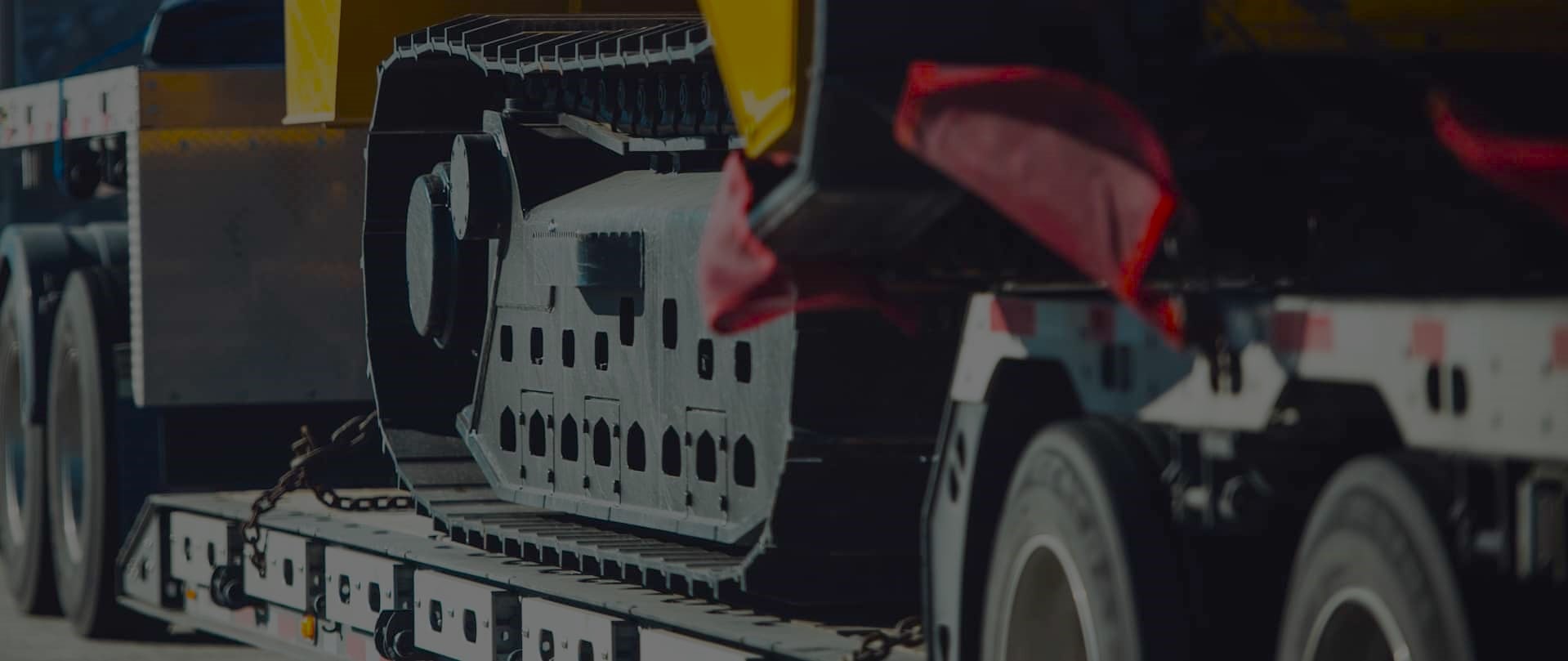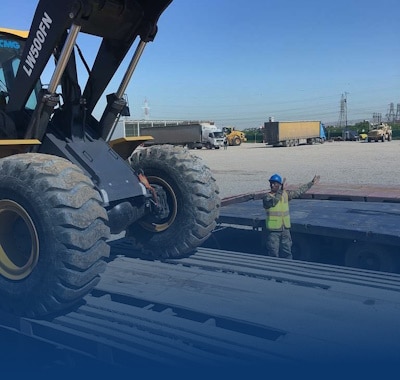Preparing Heavy Equipment for Harsh Weather Conditions
Freedom Heavy Haul can offer expedited Pickup and Delivery for any size shipment anywhere in the USA. Contact us today for No Hassle, No Pressure Pricing.
Preparing for weather challenges in heavy equipment transport is crucial. Bad weather can damage machinery, causing delays and costs. We focus on safety and reliability, making sure everything is ready for harsh weather.
Knowing the risks of unpredictable weather helps us prepare better. We use strategies to keep heavy equipment safe during transport.
We take every step seriously, from checking the equipment to securing it properly. For more tips and checks, check out this guide on preparing heavy equipment for transport in tough weather.
The Importance of Weather Preparation in Heavy Equipment Transport
Weather preparation is key to safely moving heavy equipment. Bad weather can make driving very dangerous, raising the chance of accidents. By getting ready for weather, we can keep our team and equipment safe.
Weather surprises can cause equipment problems or even big accidents. So, it’s important to be ready. This means using safe transport methods and keeping equipment in good shape for different weather.
Putting effort into weather prep shows we care about safety and doing things right. We focus on keeping our team safe and meeting our client promises. We plan carefully and act fast to deal with weather problems.
Understanding Weather Challenges for Heavy Equipment
Transporting heavy equipment means facing many weather challenges. It’s crucial to know these challenges to ensure safe and efficient transport. High winds can make it hard to control oversized loads. Rain can make roads slippery and reduce visibility, raising the risk of accidents.
Snow and ice are among the biggest threats. They can make roads very dangerous and reduce traction. Knowing these challenges helps us use the best methods for moving heavy equipment safely in bad weather. We can plan better by checking visibility and road conditions.
Our strategy for dealing with extreme weather includes being prepared and making quick assessments. Using strong plans helps us adjust to weather changes. This way, we keep the equipment safe and operations running smoothly.
Preparing for Weather Challenges in Heavy Equipment Transport
In the complex world of heavy equipment transport, understanding and preparing for weather challenges is crucial. We monitor key weather factors and set up detailed protocols. This helps us manage risks from bad weather. It makes our heavy equipment transport logistics reliable and keeps our assets safe.
Identifying Key Weather Factors to Consider
Several weather factors significantly impact the safety and efficiency of transporting heavy equipment. We carefully assess:
- Temperature: Extreme cold or heat can affect equipment performance and road conditions.
- Precipitation: Rain, snow, or ice can create hazardous driving conditions, necessitating close monitoring.
- Wind: High winds can pose risks when transporting large loads, requiring special attention to load securement.
Regularly updated weather forecasts enable us to prepare. For more detailed insight into this risk management approach, visit our section on managing risk in heavy haul transportation.
Setting Up Protocols for Adverse Weather
Clear protocols for various weather scenarios are essential. This framework involves:
- Conducting pre-trip inspections to ensure all equipment is weather-ready.
- Creating contingency plans tailored to specific weather conditions.
- Training drivers on best practices for navigating adverse weather.
By fostering a culture of preparedness, we increase our capacity to respond effectively to unpredictable weather changes. This commitment not only enhances our operational efficiency but also reflects our dedication to ensuring safe and effective heavy equipment transport logistics for weather challenges.
Best Practices for Heavy Equipment Transport in Adverse Weather Conditions
Transporting heavy equipment in bad weather needs careful planning and quick thinking. Using the right tools can make our operations safer and more reliable. By sticking to the best practices, we can keep our work going smoothly, even when the weather is not.
Utilizing Weather Forecasts and Alerts
Having the latest weather forecasts and alerts is key for planning heavy equipment transport. Modern tech and apps give us quick updates on weather dangers. This way, we can adjust our plans and lower risks. A good weather monitoring system helps us change our plans fast, keeping us ready for any weather change. For more on managing these, check here.
Choosing the Right Route and Timing
Picking the best routes and times is very important for safe heavy equipment transport. Looking at different paths helps us dodge bad weather and tough terrain. Also, choosing the right time lets us use the best weather conditions. By thinking about these things in our planning, we can make our transport safer and more efficient.
| Route Characteristics | Impact of Weather | Recommended Actions |
|---|---|---|
| Mountainous Areas | Increased risk of landslides and ice | Avoid during rain or snow forecasts |
| Poorly Maintained Roads | More likely to flood or become impassable | Plan alternatives to bypass |
| Urban Areas | Traffic congestion during adverse conditions | Schedule transport during off-peak times |
| Coastal Regions | High winds and potential storm surges | Monitor marine weather conditions closely |
Weatherproofing Your Heavy Equipment for Transport
Keeping heavy machinery safe during transport is key, even in bad weather. To protect your investment, use effective methods. One way is to cover your equipment with protective covers to keep out rain, snow, and wind.
Another method is to apply water-resistant coatings on exposed parts. This creates a shield that stops moisture from getting in. Also, make sure all mechanical parts are well-sealed. This helps prevent damage from sudden weather changes while moving.
Having a solid plan for protecting your equipment in bad weather is crucial. By using these techniques, you make your equipment more reliable and reduce the need for expensive repairs. For more tips, check out how to prepare your equipment properly.
Heavy Equipment Transport Logistics for Weather Challenges
Planning logistics well is key when dealing with weather issues in heavy equipment transport. A detailed transport plan covers every step, from loading to unloading. It’s vital to prepare for weather challenges to avoid disruptions.
Creating a Comprehensive Transport Plan
Creating a solid transport plan needs careful thought and analysis. We look at several factors, such as:
- Evaluating current weather forecasts
- Scheduling transport to avoid severe conditions
- Securing appropriate equipment for adverse weather
- Considering alternative routes that may be less impacted
This approach helps us manage logistics better, even when the weather is unpredictable.
Communicating with Your Transport Team
Good communication is at the heart of our strategy. We keep our team updated and informed. This helps us work together smoothly. We focus on:
- Regular briefings on weather developments
- Immediate reports during transport about changing conditions
- Establishing protocol for decision-making under pressure
By staying in touch, we’re better prepared for any weather surprises during transport.
Securing Heavy Equipment for Transport in Challenging Weather
Securing heavy equipment for transport in tough weather requires the right techniques and tools. Heavy-duty straps keep equipment in place during transit, no matter the weather. It’s key to check these straps often for wear or damage.
Ensuring the weight is evenly spread on the transport vehicle is also crucial. Uneven weight can cause instability, worse in windy or slippery conditions. A careful loading plan helps keep things stable, even when the weather is bad.
Doing thorough pre-transport checks is another safety step. This means checking all connections, brakes, and lights. Fixing any issues before leaving can greatly lower accident risks.
Using these best practices helps keep equipment stable and safe during transport in bad weather. By focusing on these methods, we make sure heavy equipment gets to its destination safely and on time.
Handling Extreme Weather in Heavy Equipment Transport
Dealing with extreme weather is key to keeping our operations safe and efficient. When bad weather like heavy rain, flooding, or snow and ice is coming, we need to act fast. Knowing how to handle these weather challenges helps us protect our equipment and team.
Strategies for Rain and Flood Conditions
Heavy rain and flooding are big challenges for moving heavy equipment. We check the ground before we move anything. This means looking at the risk of flooding and finding new paths if needed. Our main strategies are:
- Checking the site to see how much water there is and if the ground is stable.
- Using waterproof tarps and covers to keep equipment dry.
- Setting up ways to move water away from important areas.
Preparing for Snow and Ice Transport Conditions
Snow and ice are big dangers for moving heavy equipment. We start by watching the weather and knowing what the local climate is like. Our snow fight plan is important for keeping transport safe. Key steps are:
- Putting snow chains or special tires on vehicles to improve grip.
- Planning to move during the day to see better in the snow.
- Having drivers who know how to handle icy roads.
By using these plans, we get better at handling extreme weather when moving heavy equipment. This makes sure our work stays safe and efficient, even when it’s tough.
Heavy Equipment Transport Safety Measures During Bad Weather
Bad weather makes heavy equipment transport very challenging. It’s crucial to focus on safety to protect the equipment and the people moving it. By following strict safety protocols, we can lower risks and keep operations reliable, even in tough weather.
Training drivers is key. They need to know how to drive safely in bad weather. Regular training helps them learn how to handle big loads in difficult conditions.
It’s also important to check vehicles thoroughly before moving them. Checking tires, brakes, and lights can help avoid accidents. A checklist helps make sure everything is ready to go before we start.
- Driver Safety Training: Ongoing education on weather-related driving strategies.
- Vehicle Inspections: Routine checks of all transport equipment.
- Risk Management Techniques: Developing contingency plans for unanticipated weather changes.
By following these safety steps, we create a culture of safety. We work hard to manage risks and keep our teams safe. They are well-prepared to face any hazardous conditions.
Heavy Equipment Transport Company Weather Preparation
Weather preparation is key in heavy equipment transport to keep people and equipment safe. As a top company, we focus on training our team. They learn the latest in safety and how to handle different weather.
This training helps us act fast and well in any weather. It shows our dedication to safety.
We also check our equipment to make sure it can handle tough weather. Our fleet is both innovative and reliable. This makes us better in bad weather.
Having a safety-first culture is very important. It builds trust with our clients and partners. It makes us a reliable choice in the industry.
Our goal is to do more than just meet the basics. We aim to be ahead of the game. For more on how weather affects trucking, check out this resource. It helps improve operations in changing weather.







